FLOOD RESPONSE
A levee system has only one purpose: to protect against a flood. Every inspection made, every maintenance item addressed, every meeting attended,
and every dollar budgeted is for this specific purpose.
While we hope that flooding never occurs, a flood event is the true test of the operation and maintenance practices.
The 1993 Flood event proved to be the largest flood event to test the North Kansas City Levee Unit. On July 27, a flood on the Missouri River crested with a 529,000 cubic
feet per second peak discharge. For several weeks that summer, the District conducted around-the-clock flood fight activities, which included continuous levee patrols,
closing the stop log gap in Murray Yard, constructing a sandbag closure on Harlem Road, and coordination with North Kansas City and Kansas City, Missouri emergency responders.
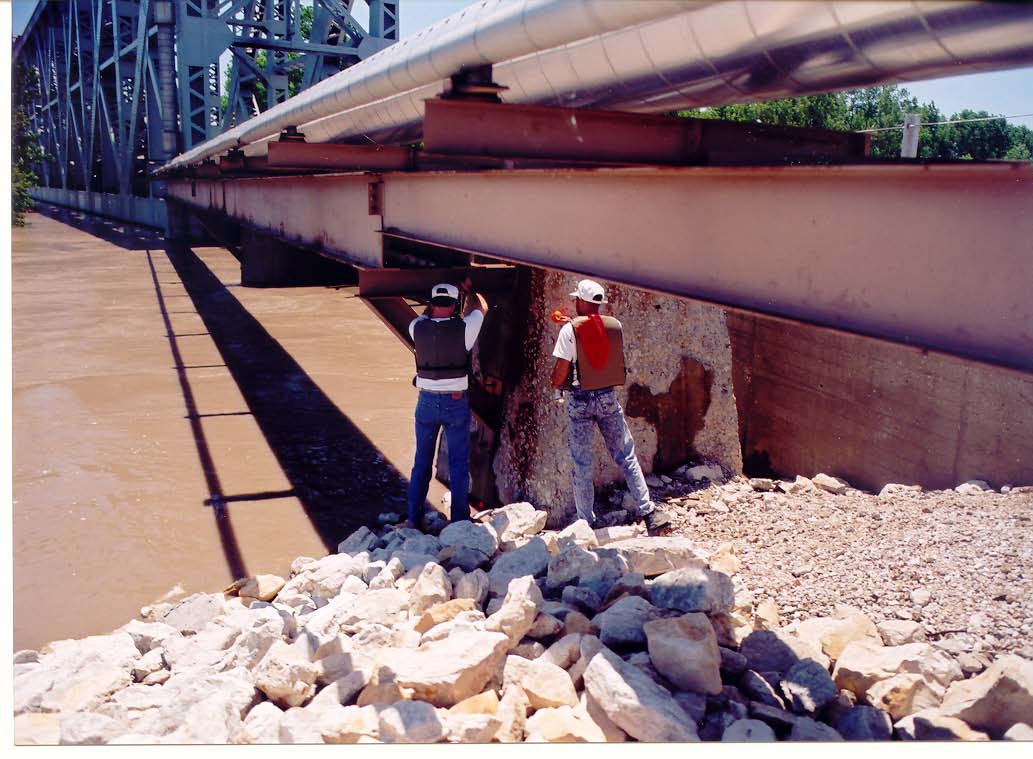
During flood events, the levee is routinely patrolled to monitor conditions. Among other responsibilities,
levee patrols measure river stages and check for debris accumulation under bridges.
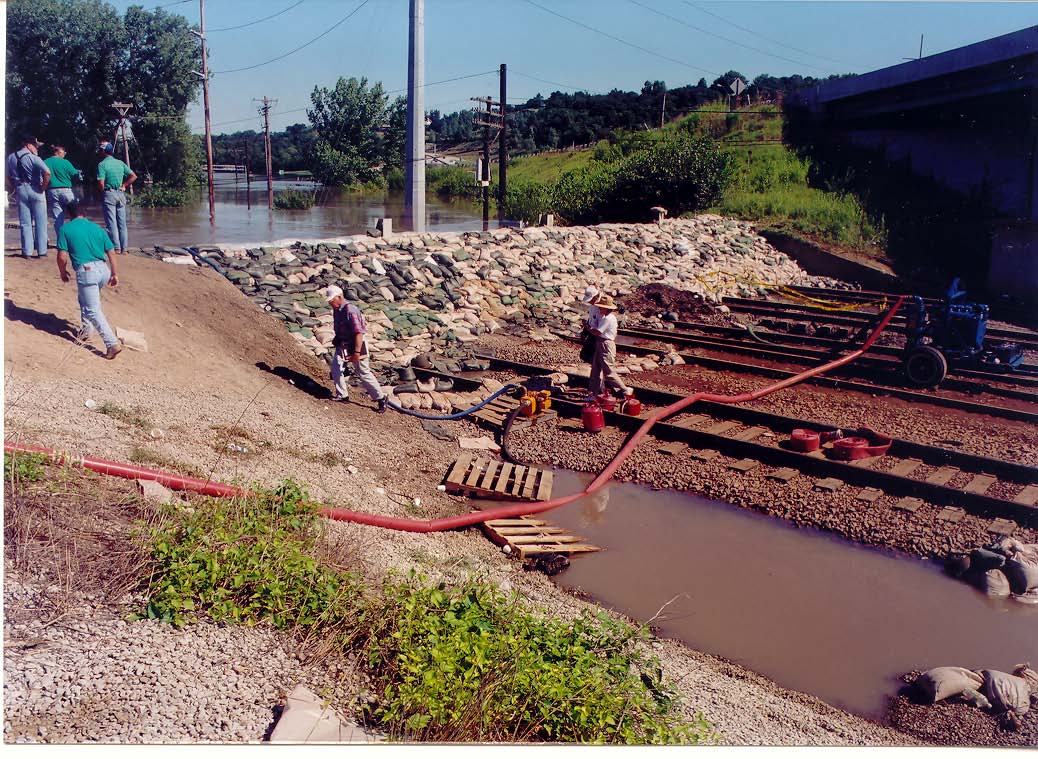
During extreme flooding, the District must close the BNSF Stop Log Gap. The gap is located at the north end of Murry Yard and allows trains to pass through the levee under normal conditions.
The only time the gap has been closed was during the 1993 Flood.
The 1993 Flood event was a catalyst for change for many local sponsors along the Missouri and Kansas Rivers. It was the first time the levee system had experienced the design flood,
and the District's flood response plan had been enacted. Many lessons were learned during the event that would prove essential to future flood fight operations.
Flooding on the Missouri River is not uncommon. On average, the District implements its Emergency Action Plan every five years. These minor flood events are taken seriously but seldom
reflect a real threat to North Kansas City. The levee system typically functions without incident, and post-flood activities are usually limited to minor cleanup and repairs.
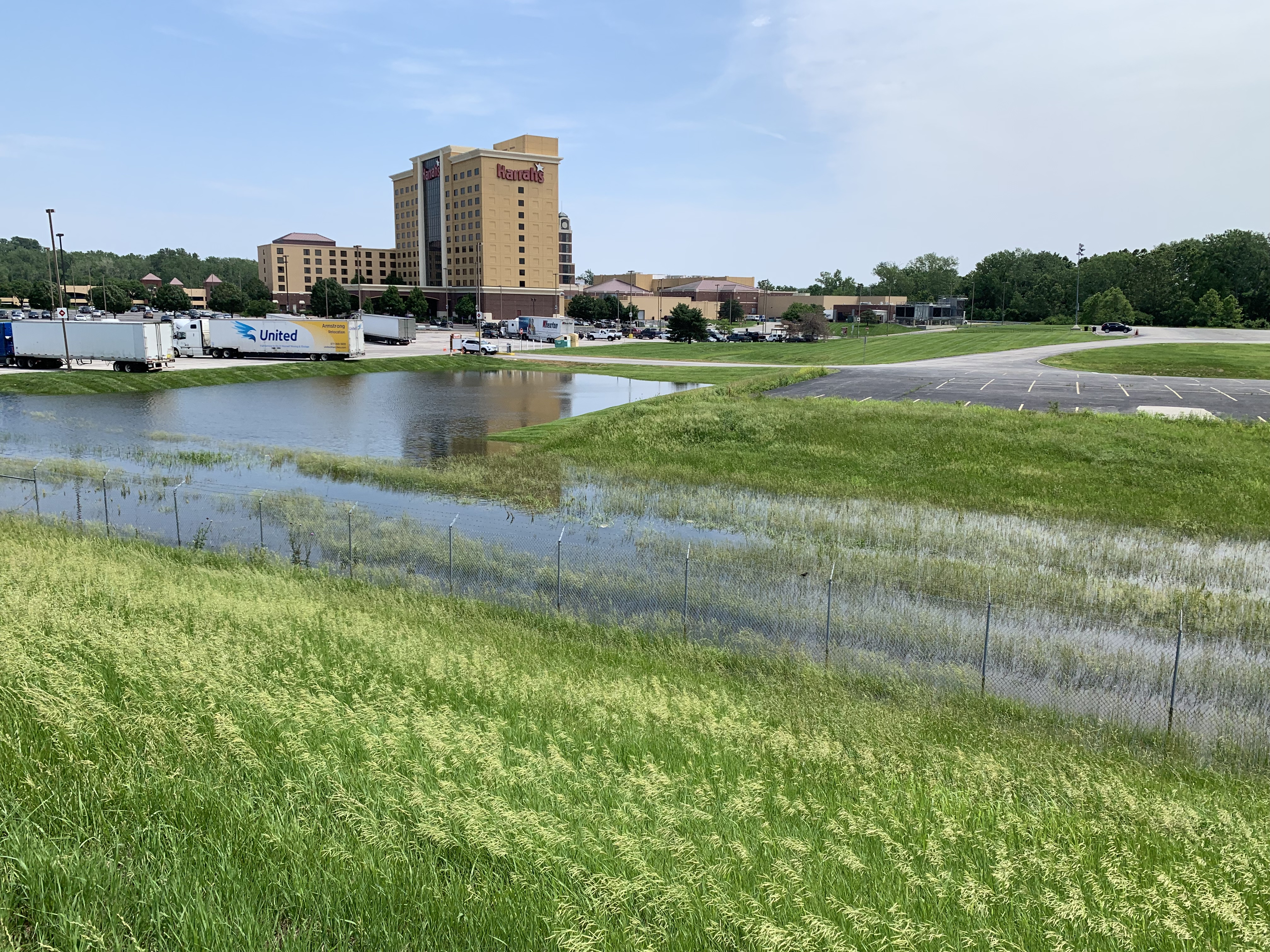
The levee system does not protect Harrah's Casino. When the river rises above the flood stage, parking lots and low-lying areas begin to flood.
Should the river get high enough, the City and Harrah's have a plan to evacuate the complex.
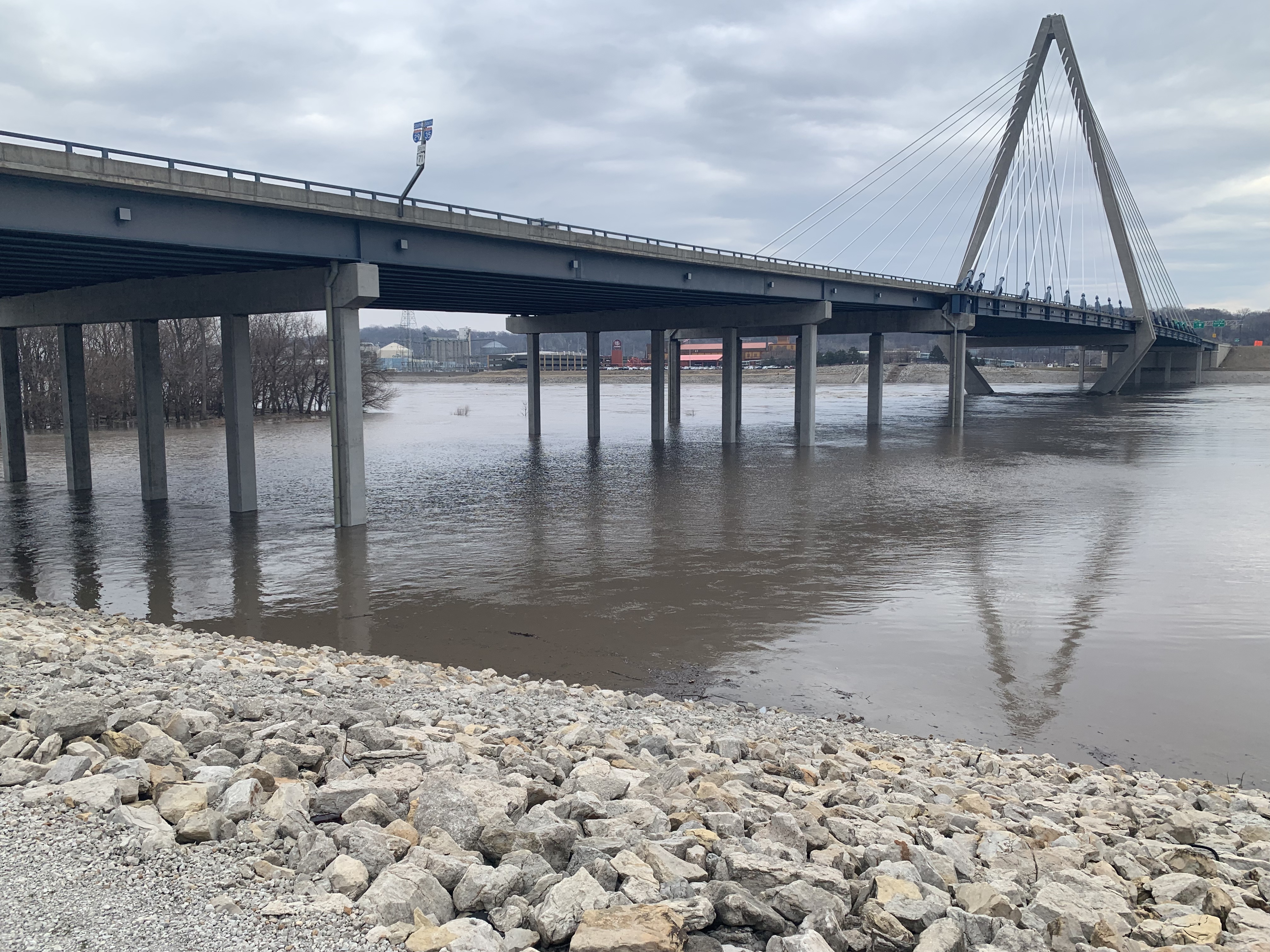
The I-29/I-35 Bridge is checked for debris during a routine patrol during the 2019 flood.
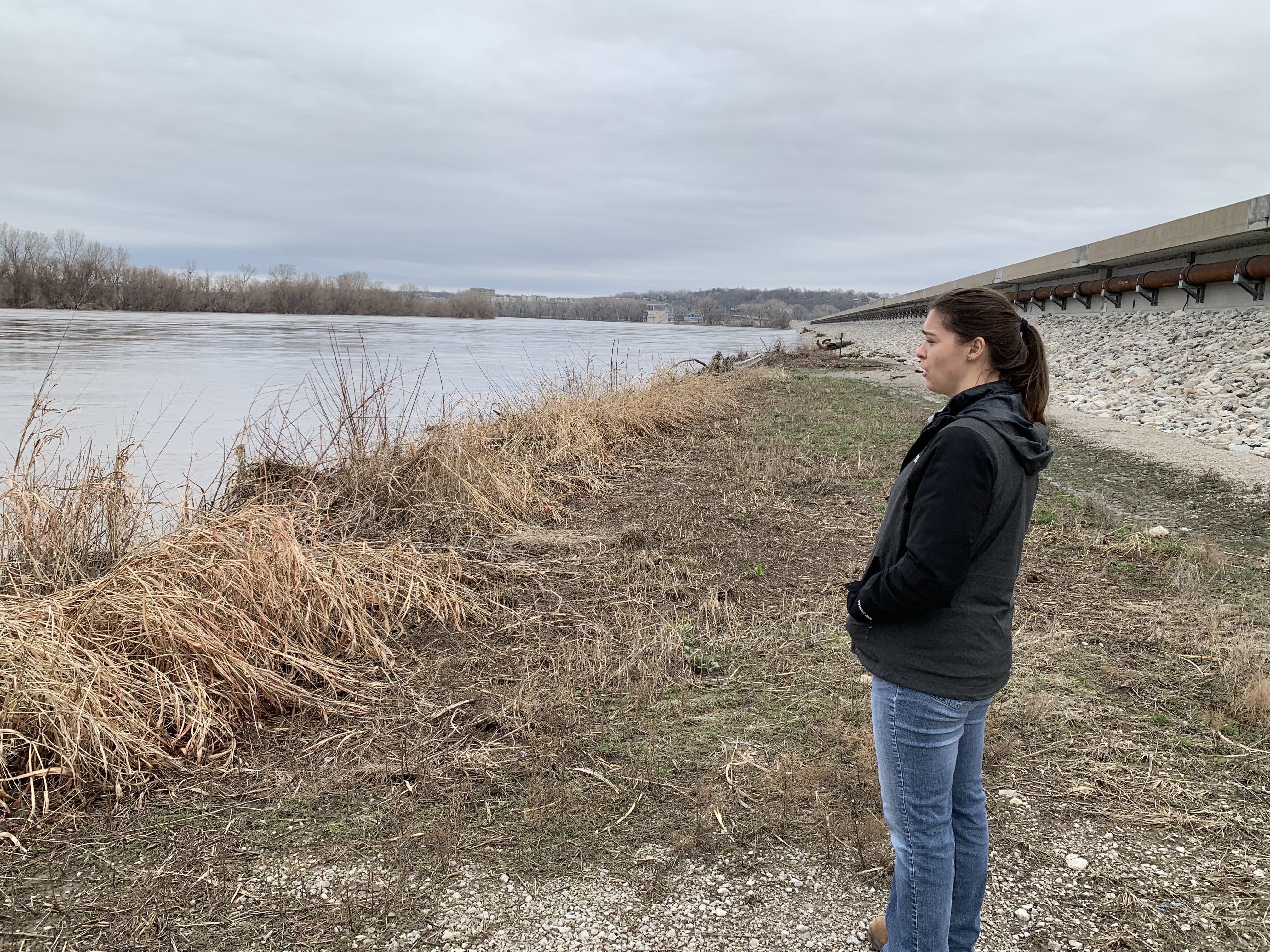
Levee patrols are mobilized when the National Weather Service forecasts flooding. This photo shows the levee patrol observing river
conditions along the Broadway Extension at the onset of the 2019 flood event.
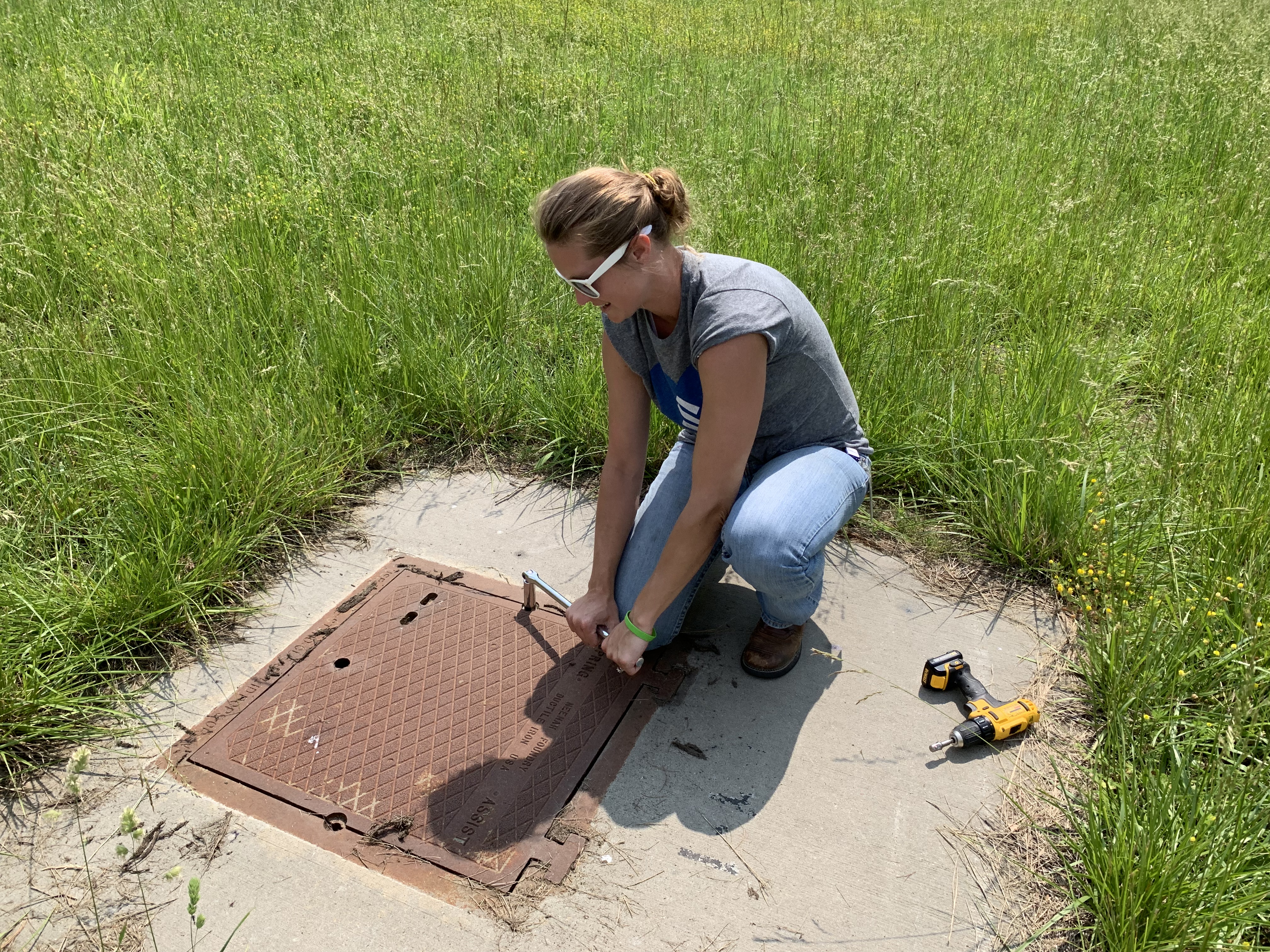
Levee patrols monitor groundwater conditions during flood events to determine when relief wells will begin to flow.
RIPRAP REPLACEMENT
The North Kansas City Levee District is committed to the continual maintenance and improvement of the levee system. One of the most significant costs associated with
levee maintenance is the riprap (large rock) that protects the slope of the levee from erosion. Over time the riprap breaks down and a new layer of riprap needs placed.
The riprap lasts 25 to 30 years before it requires replacement. The most recent riprap replacement project was completed in 2015 at $2.5 million.
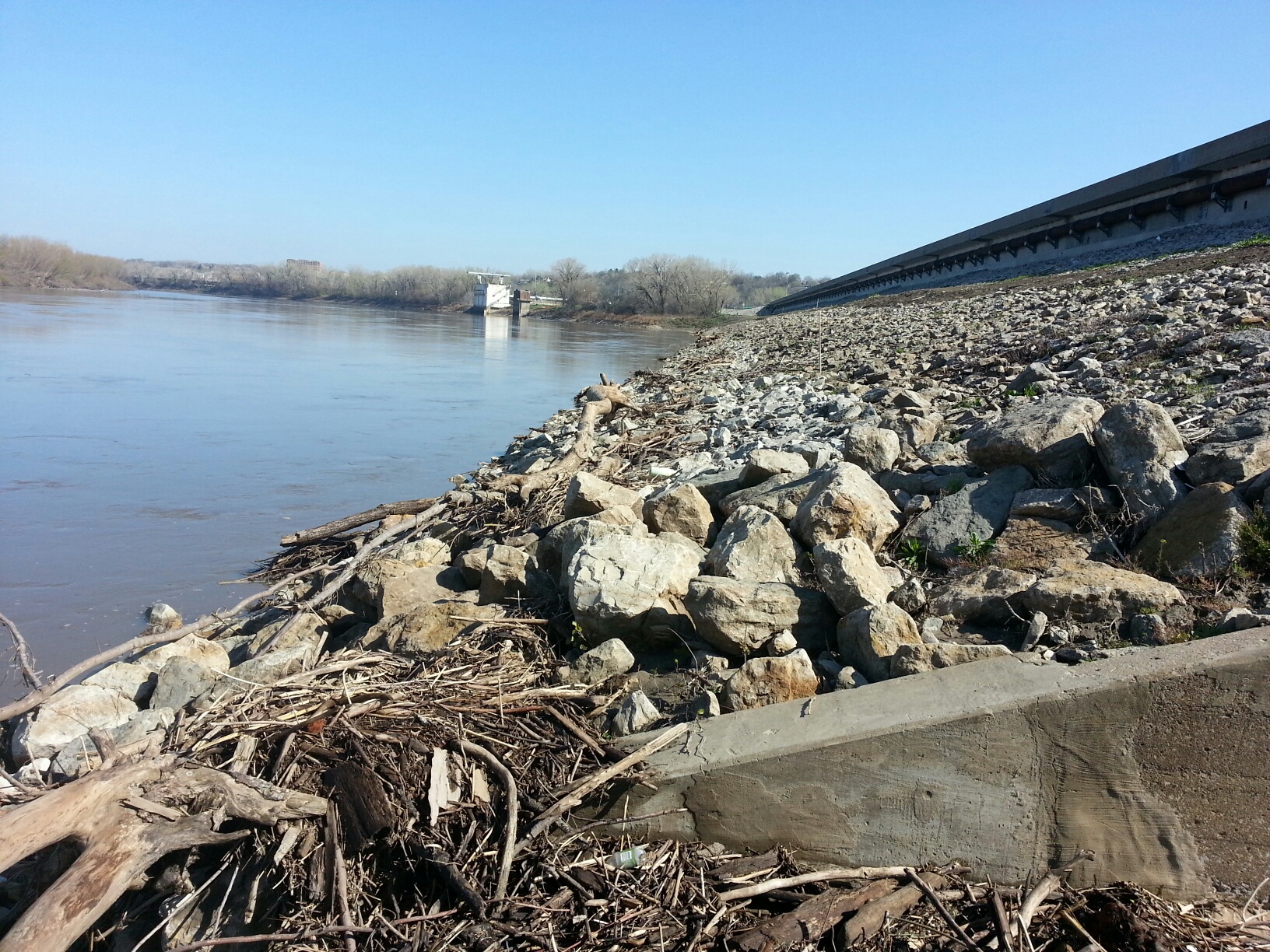
Before the 2015 overlay project, the riprap installed along the Broadway Extension in the 1980s showed signs of deterioration.
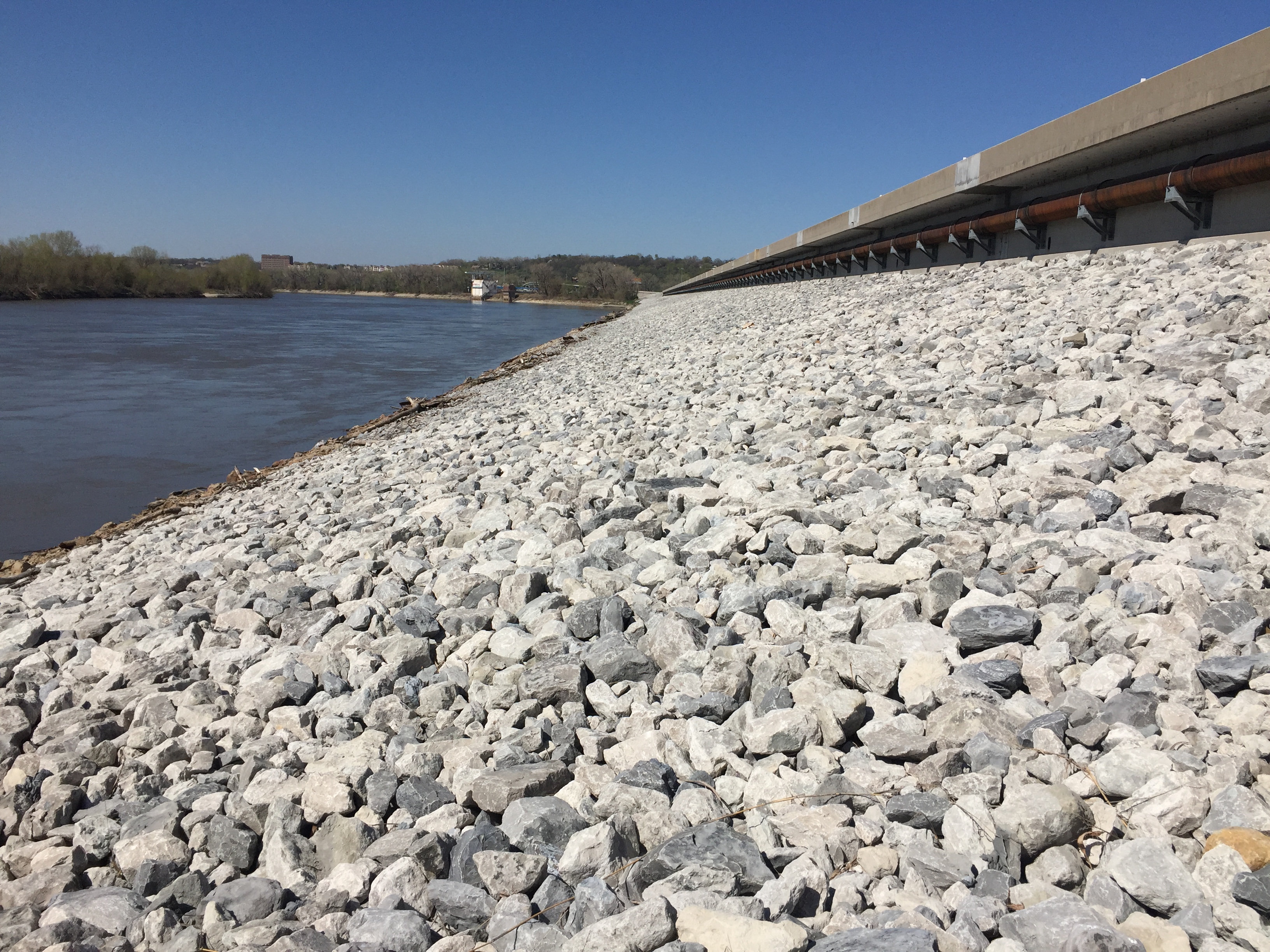
The riprap install in 2015 is expected to last 25 to 30 years before it needs to be replaced again.
The District placed 63,000 tons of rock at the cost of $2.5 million. The project was financed through a bond initiative.
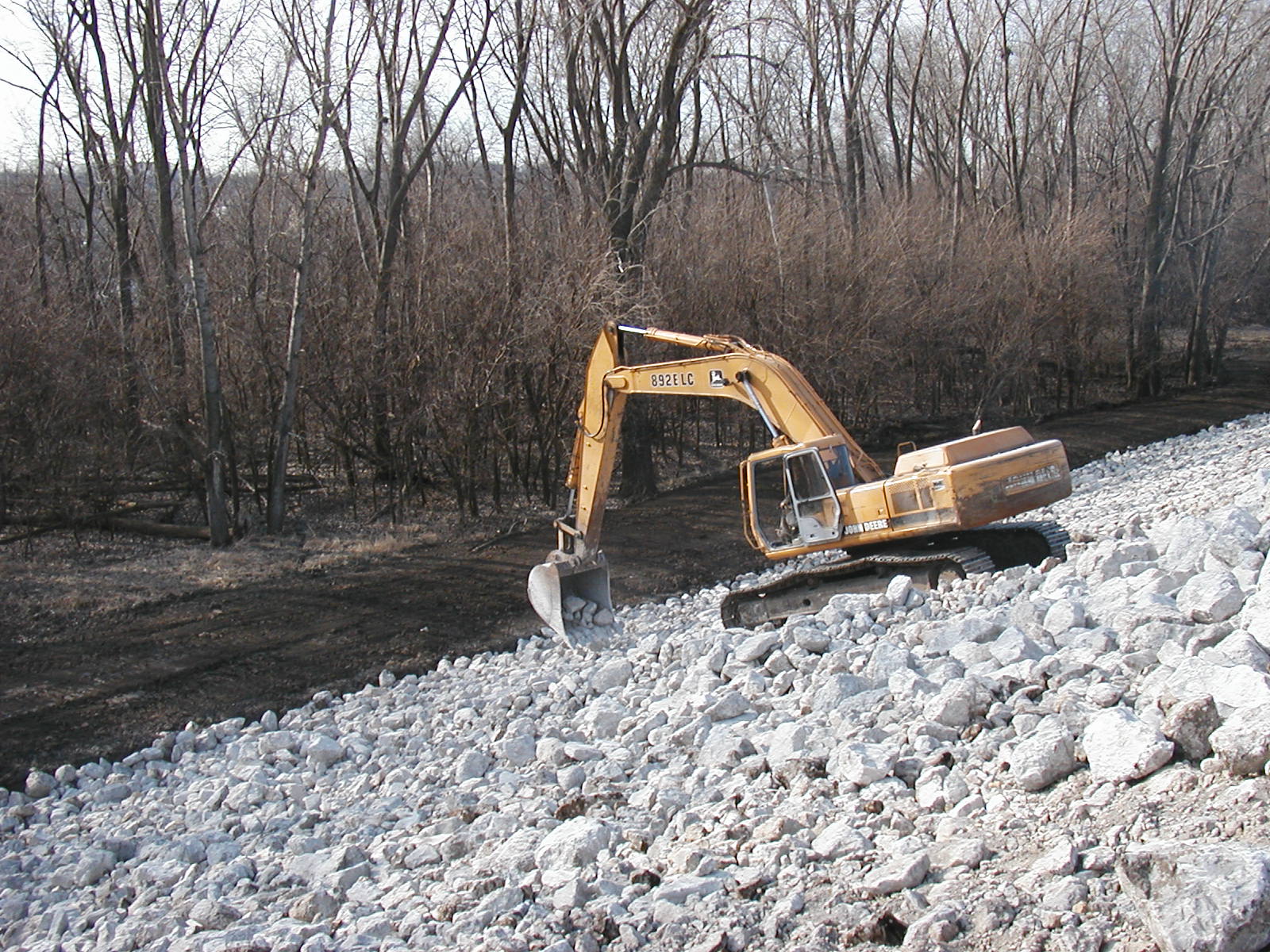
Riprap is hauled to the levee by truck and placed with a trackhoe.
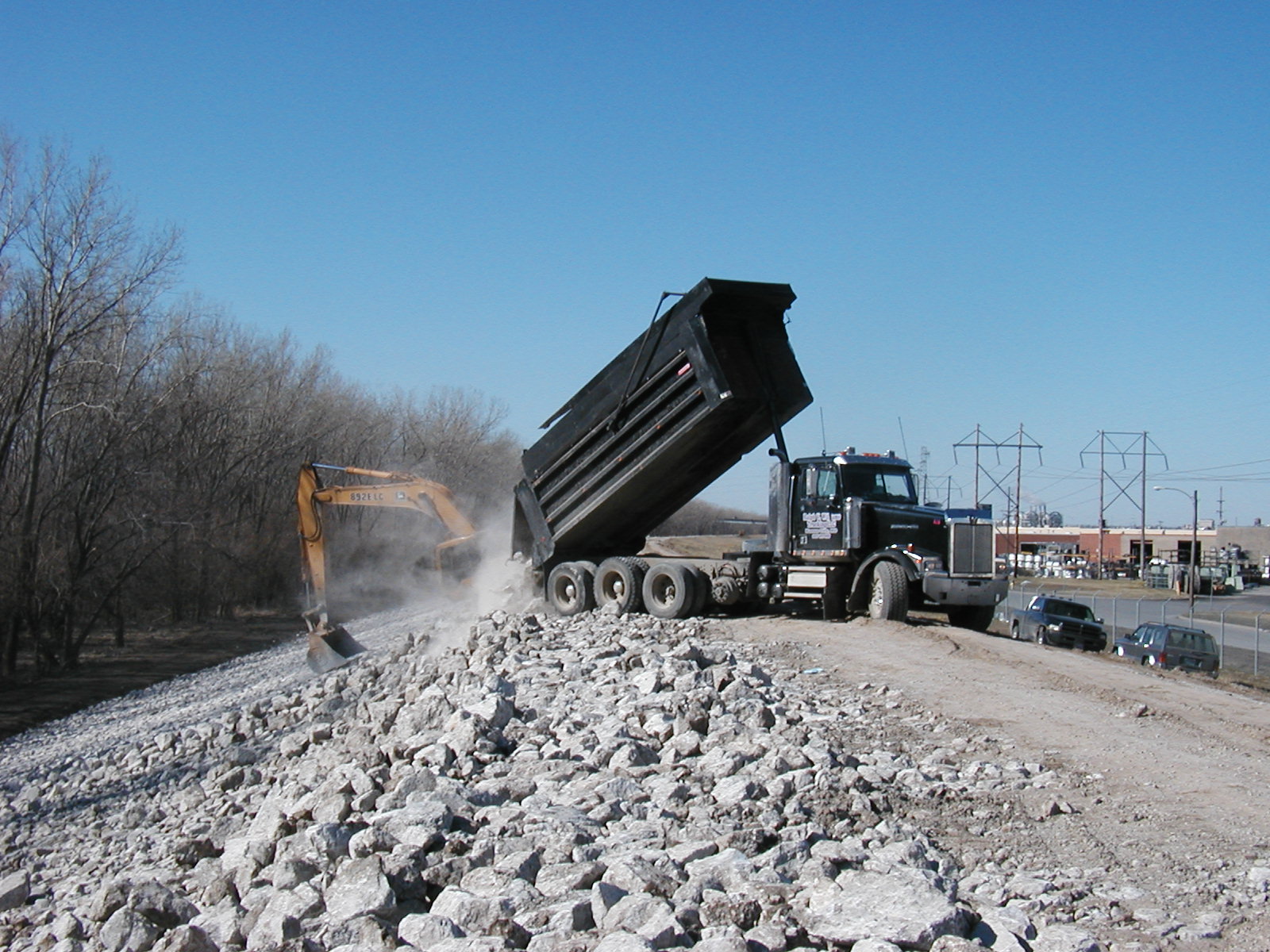
The District's riprap overlay program began in the late 1990s. Since then, new riprap had been added to sections of the levee.
The schedule for overlays is based on the condition of the rock.
CHANNEL REPAIRS
The Hillside Ditch receives runoff from more than 700 acres and conveys stormwater runoff to the Missouri River.
In 2014 the District completed work along the Hillside Ditch to stabilize the natural erosion and meandering of the channel.
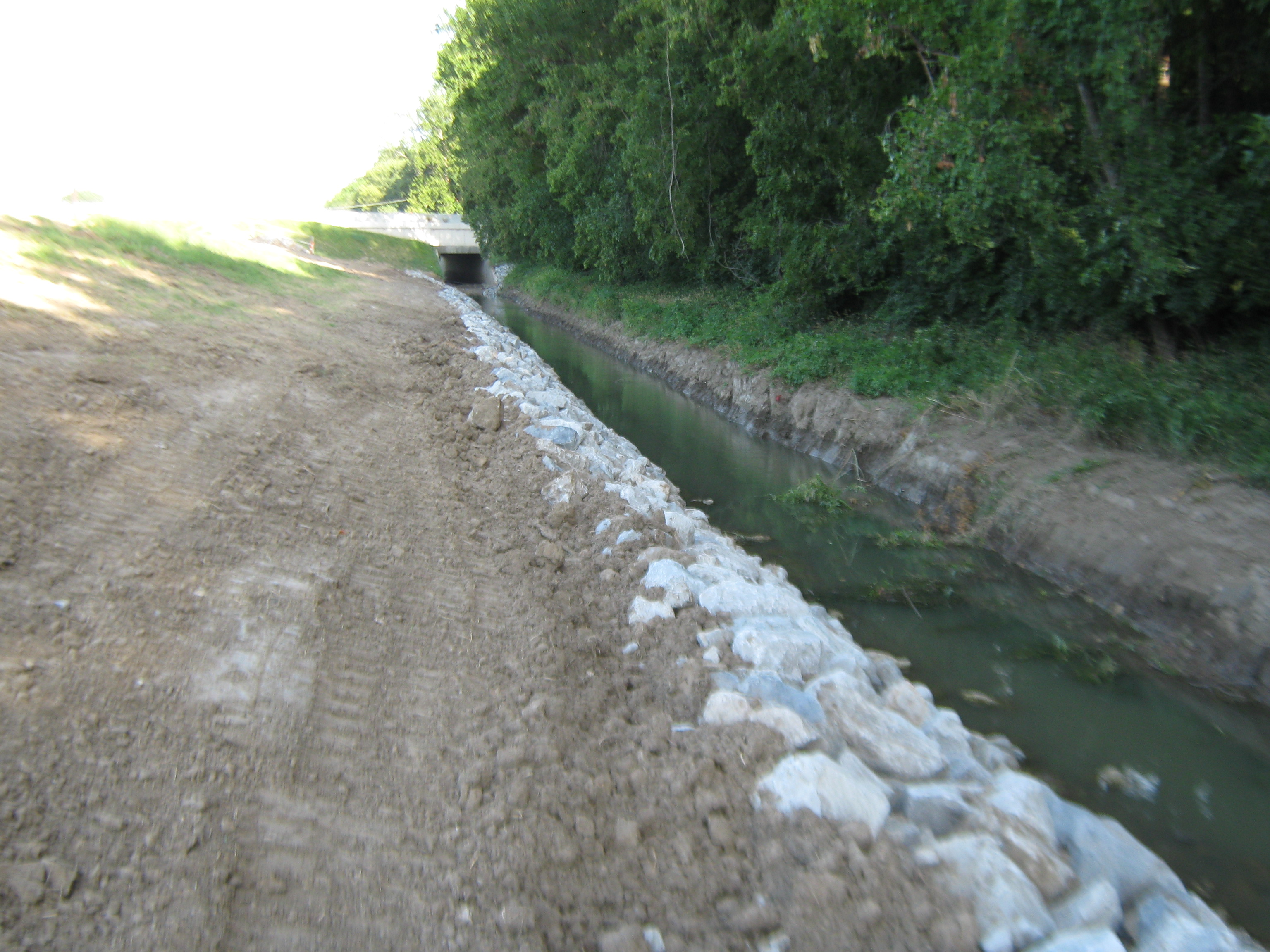
Riprap was installed along the toe of the levee to provide protection from erosion and to keep the channel from meandering.
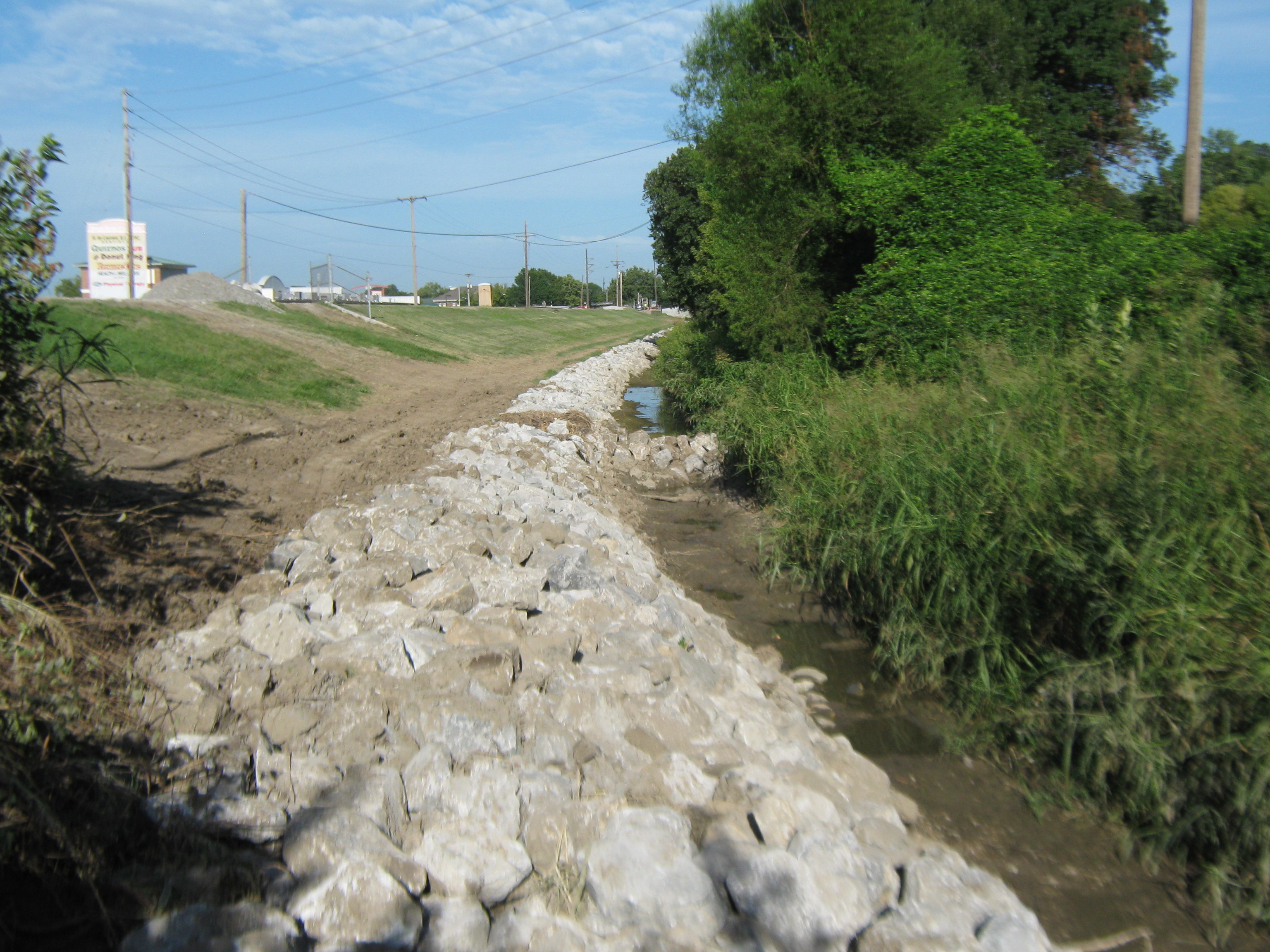
Channel repairs were made from Armour Road to Macken Park. The project has stabilized the channel, reduced maintenance costs, and improved conveyance.
PUMP STATIONS
As the system ages, operation and maintenance costs rise as repairs are needed. The District anticipates that its aging inventory of pumps will require significant maintenance,
refurbishment, or replacement within the next 10 years.
The 2019 flood event lasted almost 10 months. This event required the six pump stations to operate for an uncharacteristically long period.
As a result, one pump failed, and several others required unscheduled maintenance. The District and the City of North Kansas City worked together to
develop a plan to pull the pump, evaluate the pump motor for repair, and install a new pump motor.
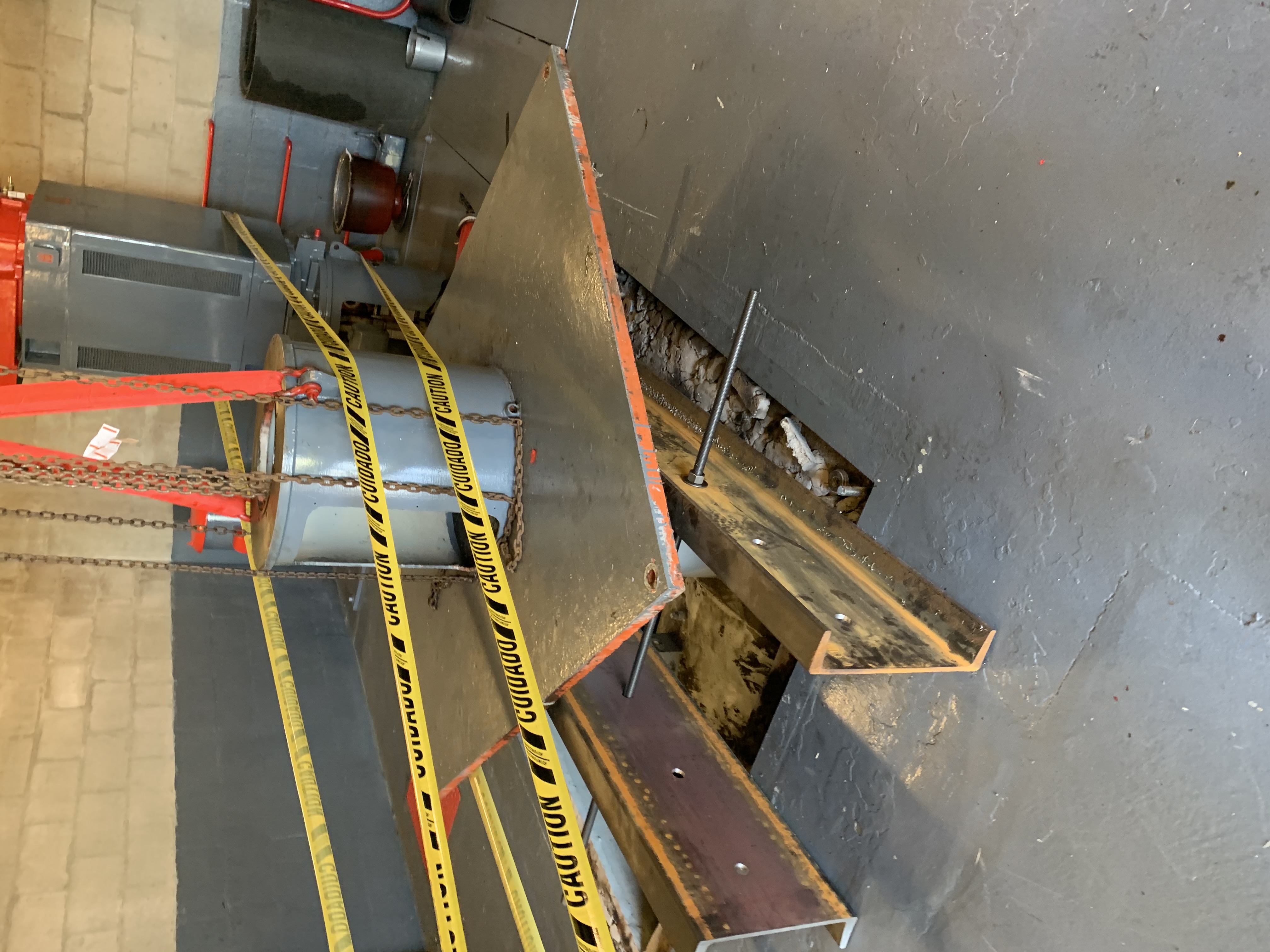
The District's pumps are large and require extensive effort to service. This pump at the Rock Creek Pump Station had to be disassembled for servicing before it was removed from the building.
OTHER REPAIR PROJECTS
The levee was designed with gaps at specific locations to allow vehicle and train traffic to pass through during normal conditions.
During flood events, a temporary closure is installed to complete the levee system and provide protection from the floodwaters.
The largest gap is located in the BNSF Murray Yard. During flood events, the closure prevents the movement of train traffic and is therefore only closed when absolutely necessary.
Train traffic through the rail yard exacts a heavy toll on the closure structure. Occasionally, the train traffic can damage the sill (the seal at the base of the temporary wall)
for the stop logs, and repairs are needed to maintain the desired level of service for the protected area.
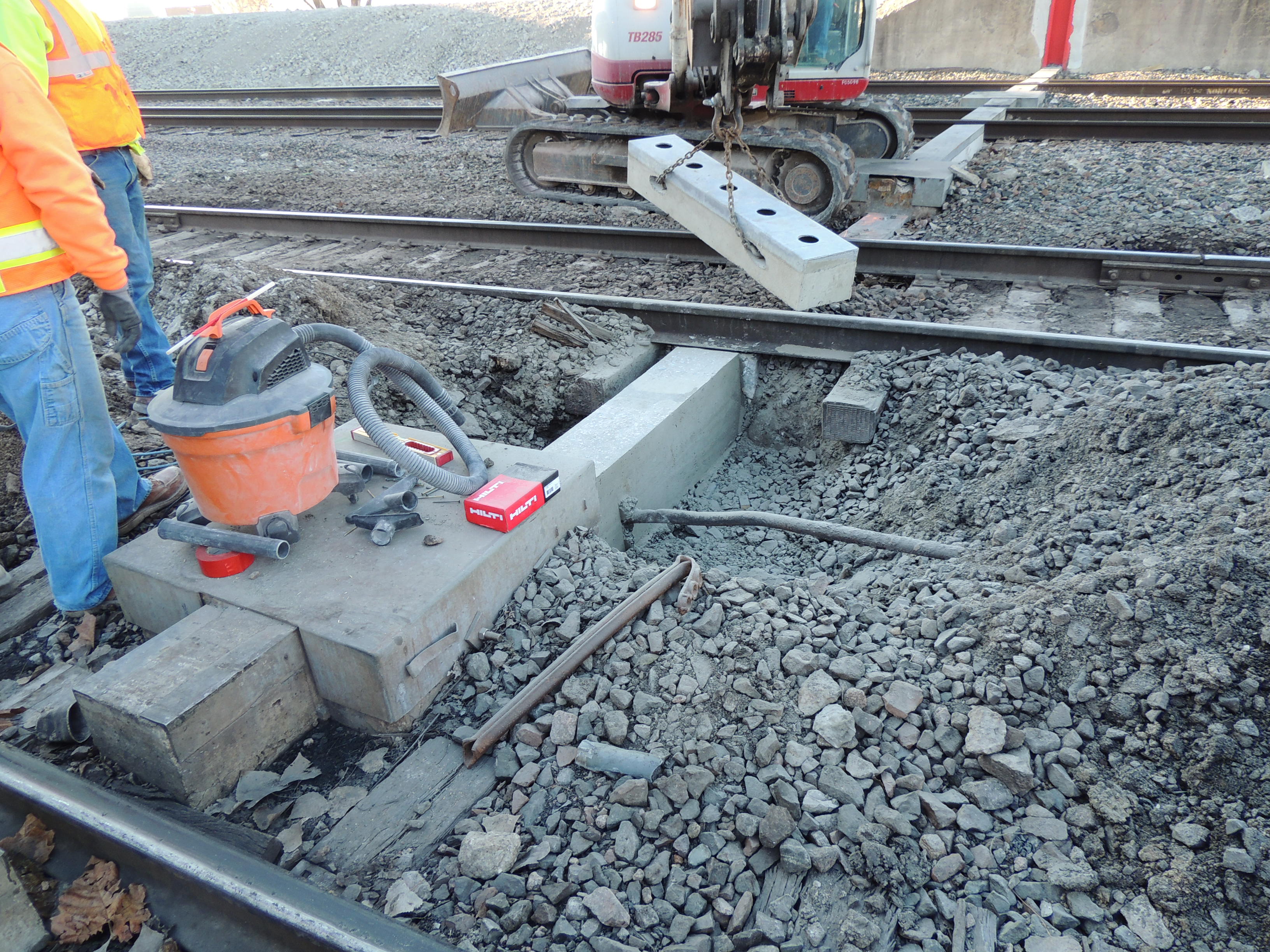
Construction crews replace a portion of the sill at the Murray Yard stoplog gap.
TRAINING
The District Engineer participates in flood fight training hosted by the U.S. Army Corps of Engineers every 2 to 3 years.
The training provides an opportunity to gain knowledge and experience to implement a future flood fight. During these training sessions,
participants learn how to fill sandbags and build sandbag structures to address problems during a flood event.
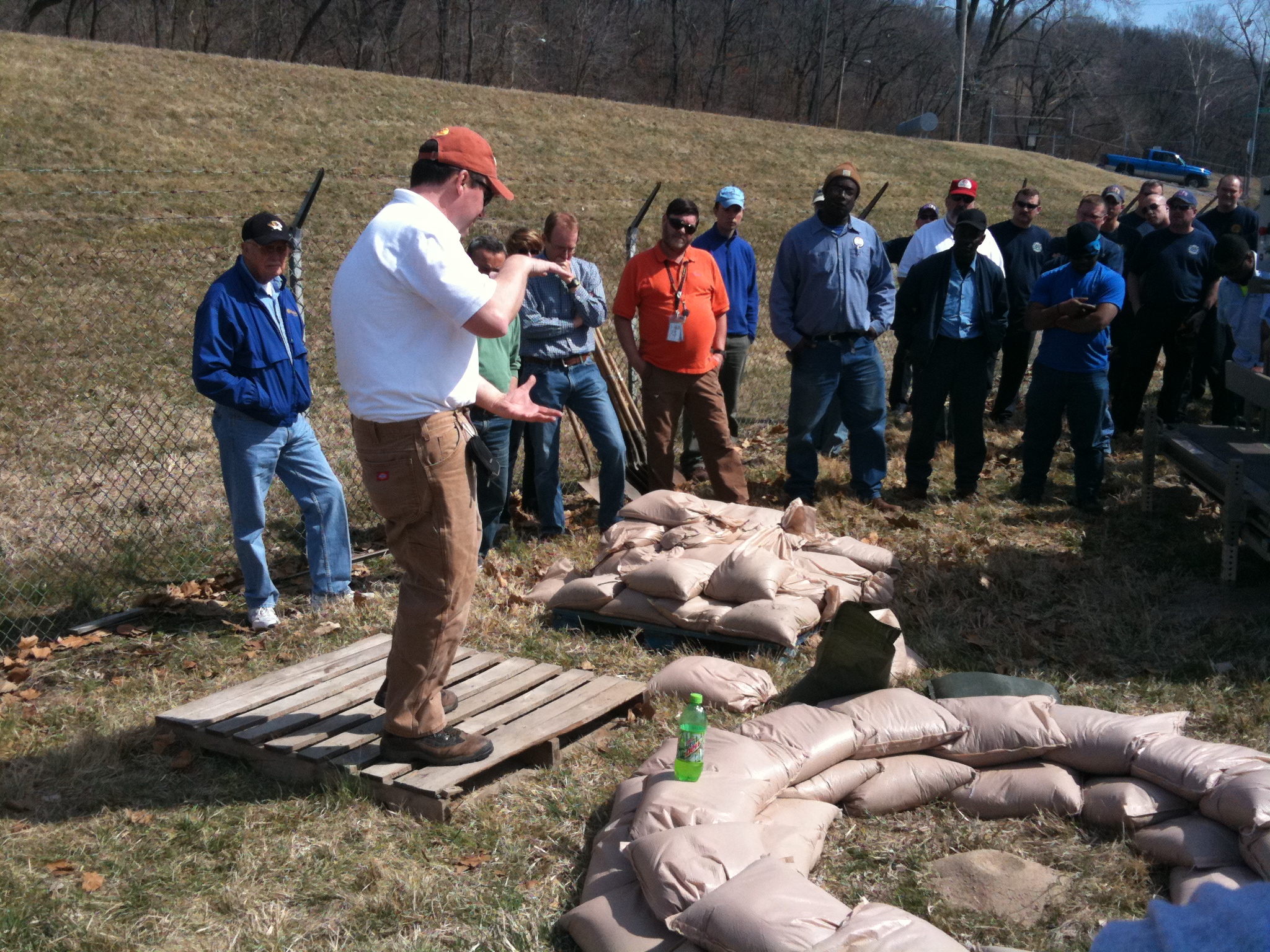
The U.S. Army Corps of Engineers provides routine training to conduct flood fight activities.
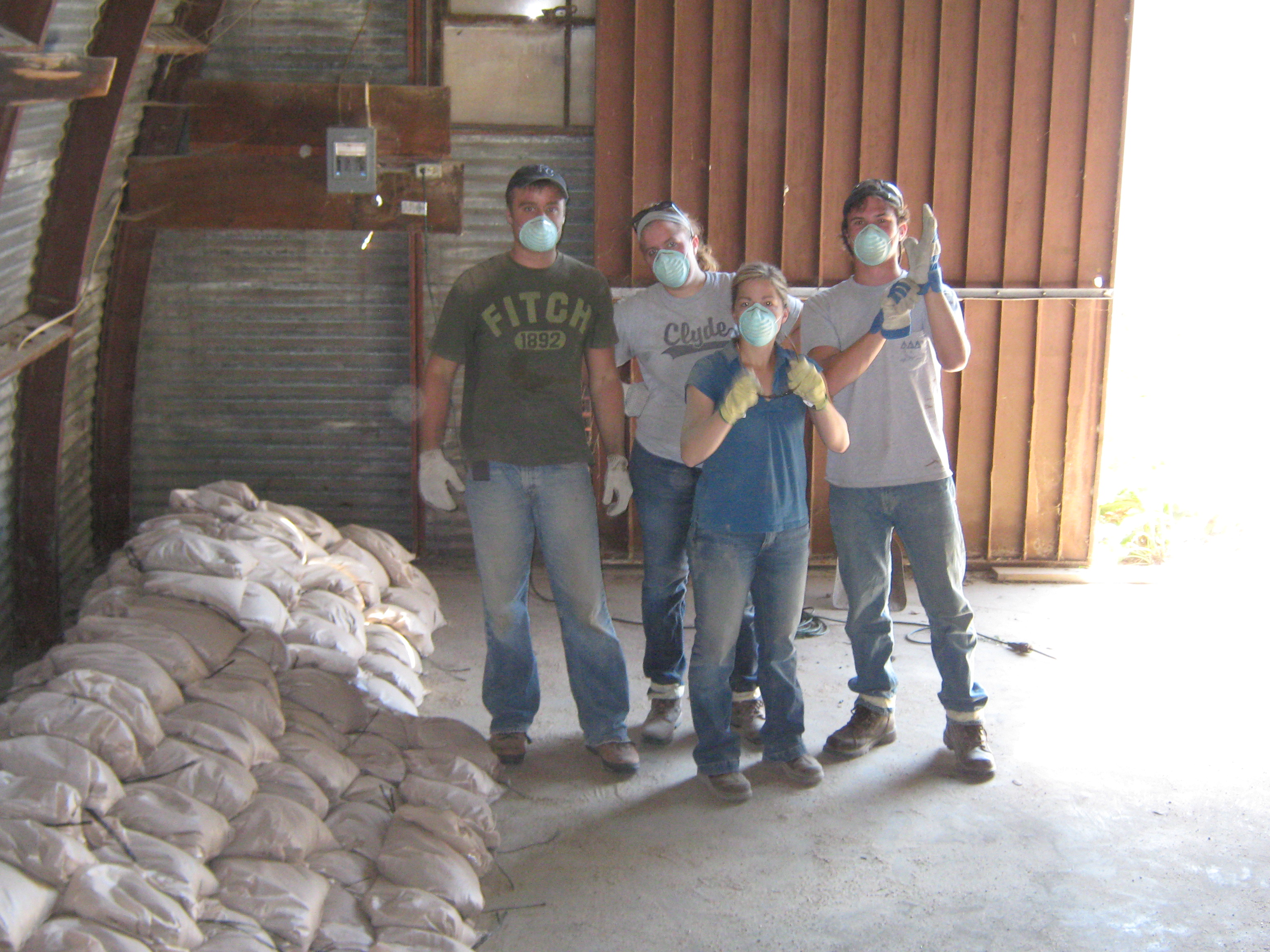
District personnel filling sandbags in preparation for the 2011 flood event.
In 2013, flooding upstream of the Missouri River at Kansas City provided the District a unique opportunity to walk through and train on the setup of the stop
log gap in BNSF's Murray Yard. Due to the upstream flooding, the railroad was not operating which allow the District a day to set up and tear down the stop logs.
Training on this stop log gap cannot occur at a regular interval due to the interruption to the train traffic. The District Engineer led the training with the North
Kansas City Fire Department, North Kansas City Public Works, Commercial Lawn Care, and BNSF Railroad to set up the stop log gap in Murray Yard located off MO-9 Highway.
This exercise was used as training and the process was documented with step-by-step assembly instructions for use in the future and to incorporate into the emergency action plan
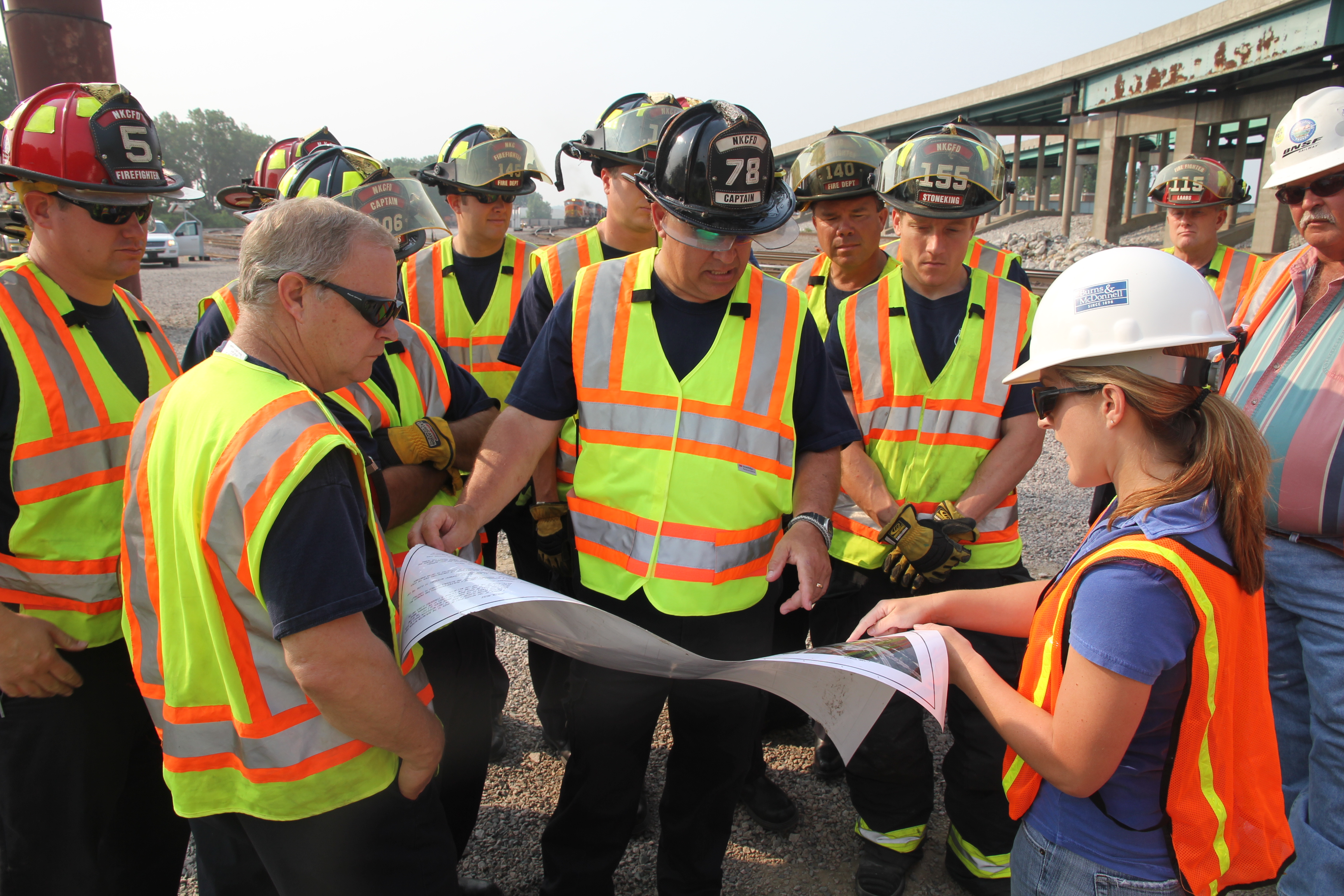
District personnel instruct the North Kansas City Fire Department on the installation of the temporary floodwall in Murray Yard.
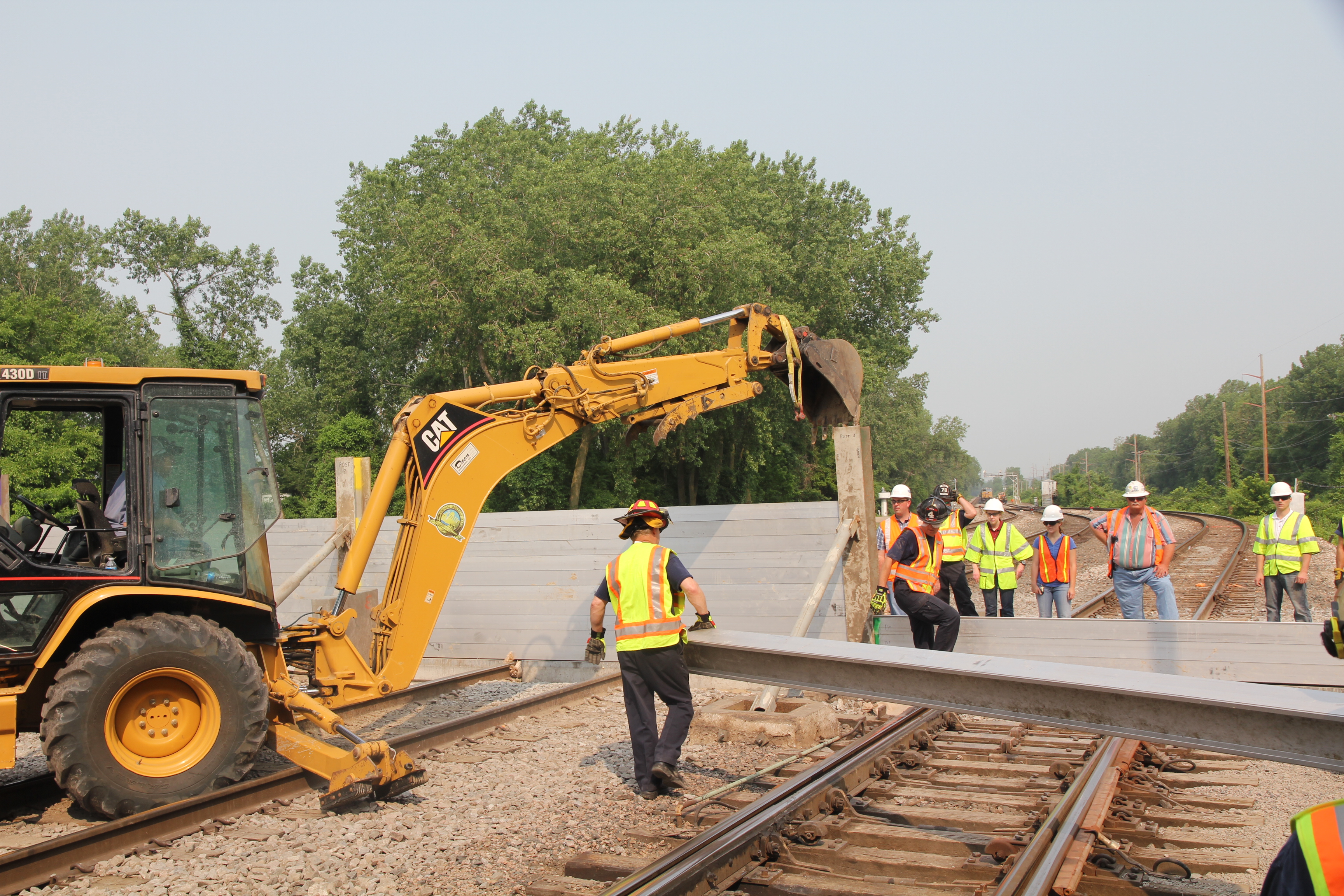
Training exercise to construct the temporary floodwall in Murray Yard.
The District owns and operates two portable pumping systems to remove the Harlem area's seepage water. The pumps must be operated during moderate flooding conditions.
Construction in 2013, the Harlem Underseepage System reduces the chances of flooding in Harlem that occurred during the 1993 Flood.
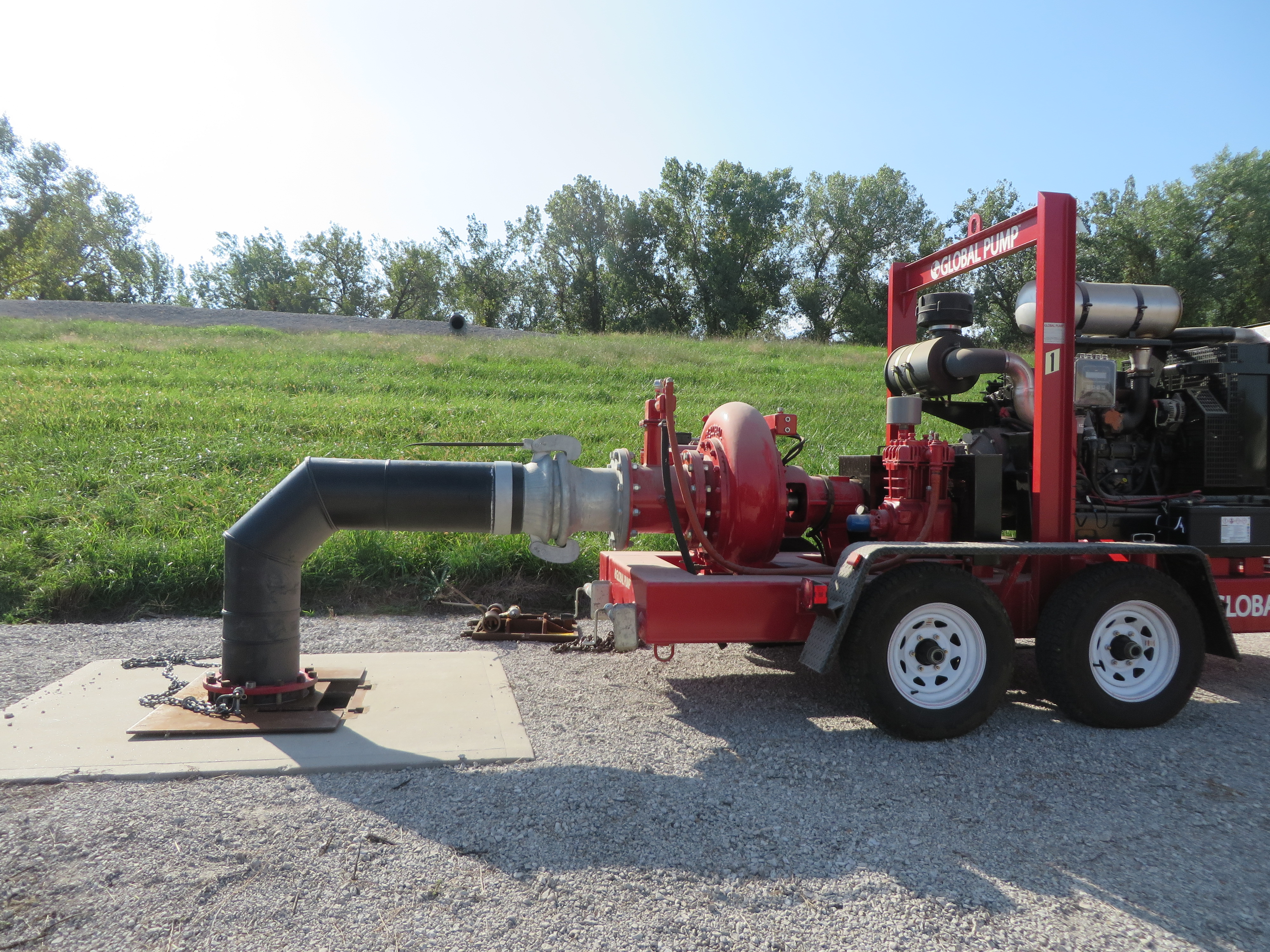
Trailer-Mounted Pump used for the Harlem Underseepage System.
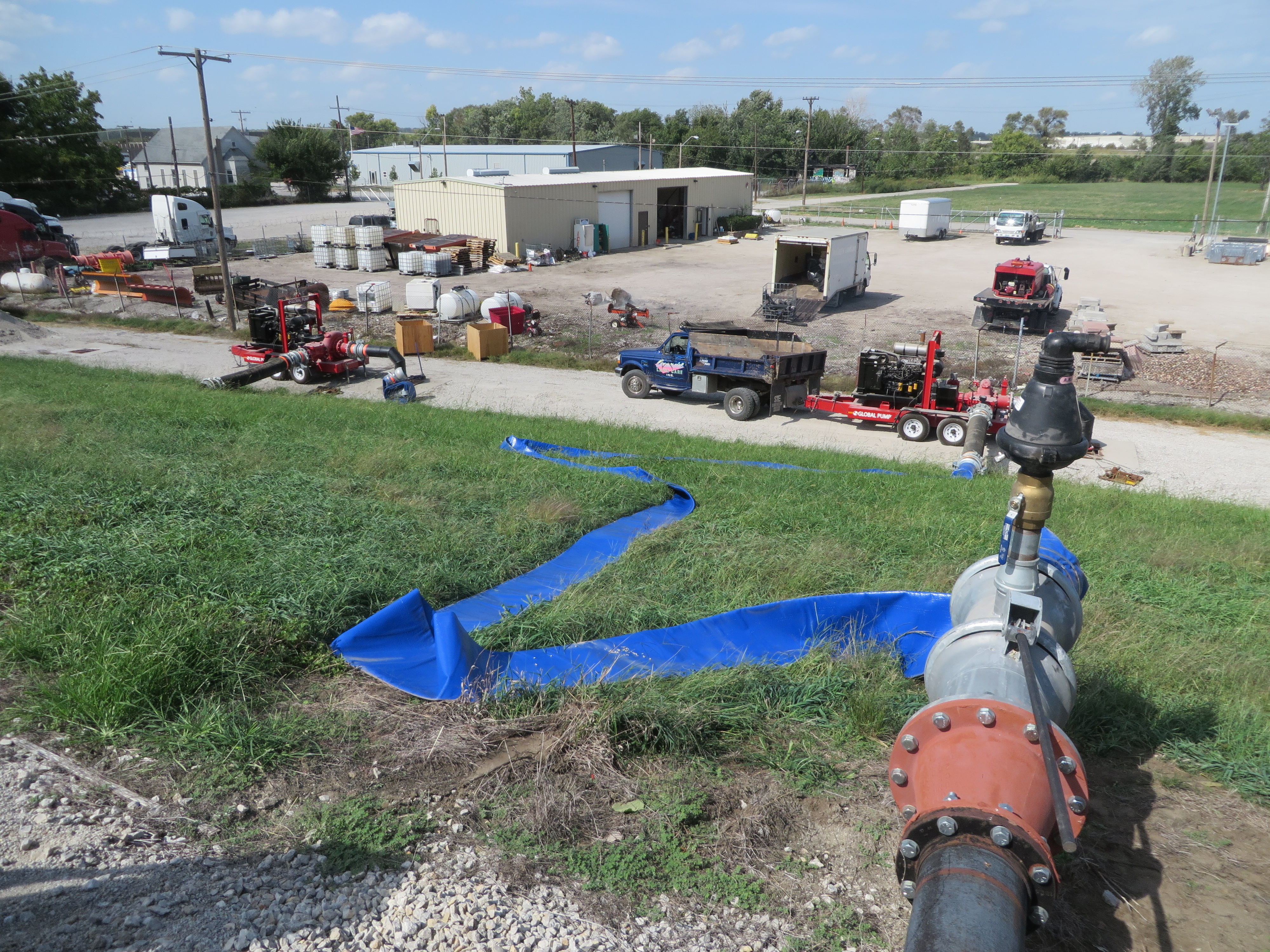
Routine training to setup the District’s portable pumping systems.
FLASH FLOOD RESPONSE
The District has a long-standing partnership with the North Kansas City Fire Department to assist with flood fight activities and emergency preparedness.
During flash floods, the fire department closes the stop log gaps at N. Holmes and N. Cherry Streets. These gaps in the levee allow traffic to pass over the levee.
During flooding conditions, the gaps must be closed to traffic, and a temporary wall is constructed to contain flood water. As part of the District's emergency action plan,
routine training is provided to the fire department to assemble the walls.
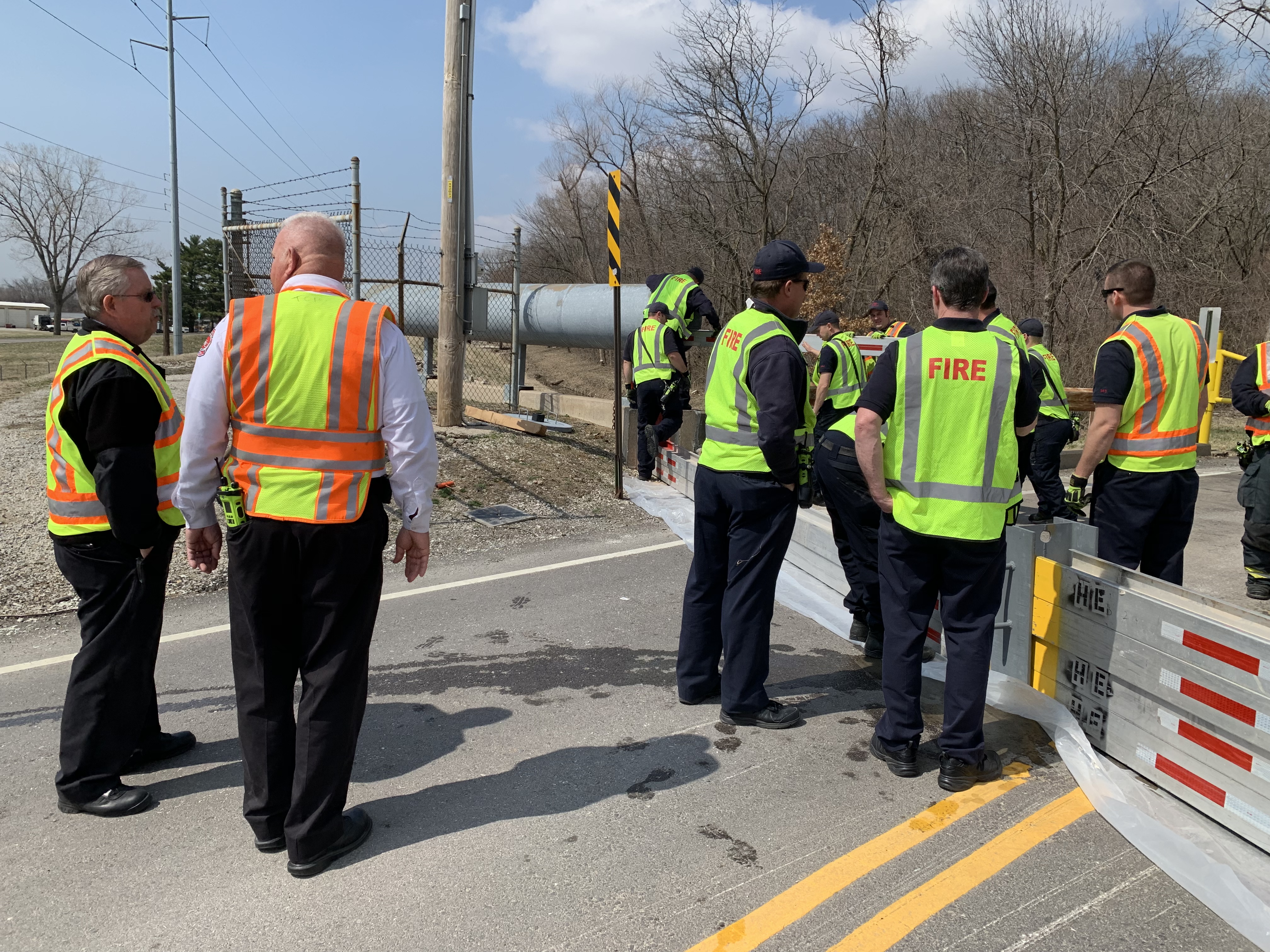
The North Kansas City, Missouri Fire Department assembles the N. Cherry and N. Holmes stop log gaps as part of the the District routine training program.